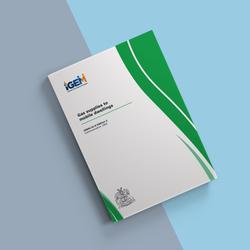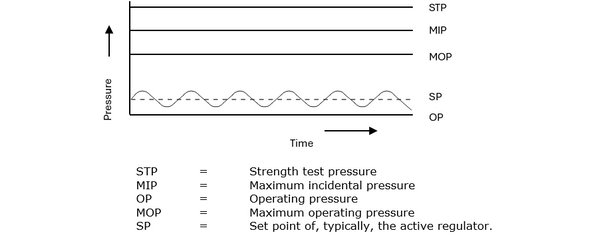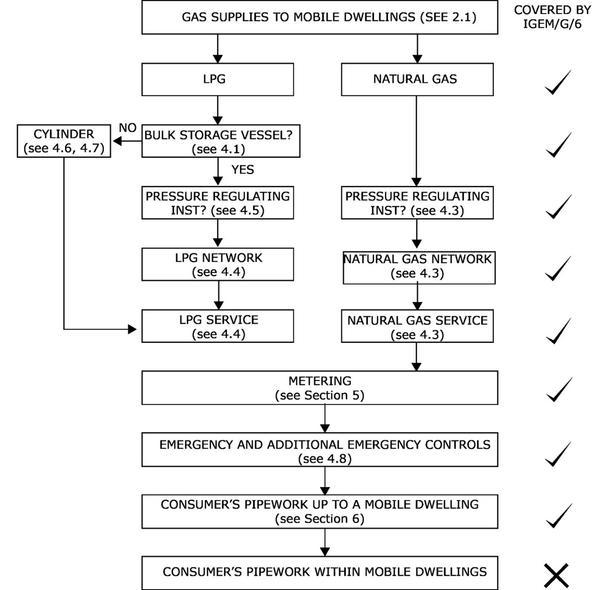IGEM/G/6 Edition 2 - Gas supplies to mobile dwellings

This Standard has been produced primarily for the benefit of network designers, operators of caravan parks and marinas, and gas operatives, providing best practice on distributing, metering and installing Natural Gas (NG) and liquefied petroleum gas (LPG) (including cylinder and bulk storage) plant, along with additional requirements, interpretation and clarification of national legislation, standards and Codes of Practice (CoPs).
It addresses the design, installation, testing, purging, commissioning, operation, maintenance and decommissioning of gas supply systems up to the point of connection to prefabricated pipework on holiday caravans, residential park homes and waterborne accommodation. It covers new and complete replacement bulk storage vessels, network pipes, meter installations and installation pipework (including secondary meters).
This Standard covers odorised 2nd family gas (for example NG) and 3rd family gas (for example LPG). It covers piped gas supplied from:
- a NG network
- an LPG central bulk storage vessel and network
- an independent LPG supply i.e., either a cylinder or an individual bulk storage vessel.
Introduction
SECTION 1 : INTRODUCTION
1.1 This Standard supersedes IGEM/G/6, Communication 1728, 2009 Edition.
1.2 This Standard has been drafted by a Panel appointed by the Institution of Gas Engineers and Managers’ (IGEM’s) Gas Utilisation Committee and has been approved by IGEM’s Technical Co-ordinating Committee on behalf of the Council of IGEM.
1.3 This Standard has been produced primarily for the benefit of network designers, operators of caravan parks and marinas, and gas operatives, providing:
- additional requirements, interpretation and clarification of national legislation, standards and Codes of Practice (CoPs) (without duplicating or replacing these)
- best practice on distributing, metering and installing Natural Gas (NG) and liquefied petroleum gas (LPG) (including cylinder and bulk storage) plant
- details of Legislation, CoPs, health and safety requirements and Regulations etc. that are applicable (see also Appendix 2).
1.4 This Standard reflects current recommended practice. It directs readers to the numerous established national Standards and Legislation, and additionally includes requirements specific to mobile dwellings (see Sub-Section 2.1).
1.5 IGEM has adopted the terms and definitions used in European standards for pressure i.e., maximum operating pressure (MOP), operating pressure (OP), maximum incidental pressure (MIP) and strength test pressure (STP). Figure 1 explains these terms.
1.6 This Standard makes use of the terms “must”, “shall” and “should” when prescribing particular requirements. Notwithstanding Sub-Section 1.9:
- the term “must” identifies a requirement by law in Great Britain (GB) at the time of publication
- the term “shall” prescribes a procedure which, it is intended, will be complied with in full and without deviation
- the term “should” prescribes a procedure which, it is intended, will be complied with unless, after prior consideration, deviation is considered to be acceptable.
Such terms may have different meanings when used in Legislation, or Health and Safety Executive (HSE) Approved Codes of Practice (ACoPs) or guidance, and reference needs to be made to such statutory Legislation or official Guidance for information on legal obligations.
1.7 The primary responsibility for compliance with legal duties relating to health and safety at work rests with the employer or the person in control. The fact that certain employees, for example “responsible engineers”, are allowed to exercise their professional judgement does not allow employers to abrogate their primary responsibilities. Employers are required to:
- have done everything to ensure, so far as is reasonably practicable, that there are no better protective measures that can be taken other than relying on the exercise of professional judgement by “responsible engineers”
- have done everything to ensure, so far as is reasonably practicable, that “responsible engineers” have the skills, training, experience and personal qualities necessary for the proper exercise of professional judgement
- have systems and procedures in place to ensure that the exercise of professional judgement by “responsible engineers” is subject to appropriate monitoring and review
- not require “responsible engineers” to undertake tasks which would necessitate the exercise of professional judgement that is not within their competence. There should be written procedures defining the extent to which “responsible engineers” can exercise their judgement. When “responsible engineers” are asked to undertake tasks which deviate from this, they are to refer the matter for higher review.
1.8 It is now widely accepted that the majority of accidents in industry generally are in some measure attributable to human as well as technical factors. People who initiated actions that caused or contributed to accidents might have acted in a more appropriate manner to prevent them.
To assist in the control of risk and proper management of these human factors, due regard is to be taken of HSG48 and HSG65.
1.9 Notwithstanding Sub-Section 1.6, this Standard does not attempt to make the use of any method or specification obligatory against the judgement of the responsible engineer. Where new and better techniques are developed and proved, they are to be adopted without waiting for modification to this Standard. Amendments to this Standard will be issued when necessary and their publication will be announced in the Journal of the Institution and other publications as appropriate.
1.10 Requests for interpretation of this Standard in relation to matters within its scope, but not precisely covered by the current text, are to be either:
- addressed to Technical Services, IGEM, IGEM House, 26-28 High Street, Kegworth, Derbyshire, DE74 2DA, or
- emailed to [email protected]
These will be submitted to the relevant Committee for consideration and advice, but in the context that the final responsibility is that of the engineer concerned. If any advice is given by or on behalf of IGEM, this does not relieve the responsible engineer of any of his or her obligations.
1.11 This Standard was published in July 2024.

FIGURE 1 - OPERATIONAL PRESSURE LIMITS
Scope
SECTION 2 : SCOPE
2.1 This Standard addresses the design, installation, testing, purging, commissioning, operation, maintenance and decommissioning of gas supply systems (see Figure 2) up to the point of connection to prefabricated pipework on:
- holiday caravans (sometimes referred to as chalets, lodges or villas)
- residential park homes (sometimes referred to as chalets, lodges or villas)
- waterborne accommodation (often referred to as permanently moored boats).
Note 1: Further, specialist advice is required for gas supply systems for permanently moored boats used for commercial or industrial purposes.
Note 2: These items are collectively referred to in this Standard as “mobile dwellings” and are defined and described in Appendix 1 or IGEM/G/4.
The Standard does not specifically address single or multiple stanchions that offer plug-in connections for various services to touring caravans and motor homes (sometimes referred to as “super pitches”). Guidance on such stanchions may be sought from the gas supplier.
2.2 This Standard covers odorised 2nd family gas (for example NG) and 3rd family gas (for example LPG).
Note: Both propane and butane are covered in general. However, the use of butane is not generally recommended due to limitations regarding pressure and temperature (see Appendix 3). Its use is normally limited to cylinders.
While these comprise the majority of fuel gases available, the Standard will, on the whole, be applicable for other fuel gases, for example LPG/air, although cognisance has to be taken of special properties of such gases both in the burned and unburned state.
2.3 For LPG, the nominal operating pressure downstream of any emergency control valve (ECV) is to be 37 mbar.
2.4 This Standard covers piped gas supplied from:
- a NG network
- an LPG central bulk storage vessel and network
- an independent LPG supply i.e., either a cylinder or an individual bulk storage vessel.
Figure 2 illustrates this scope.
2.5 This Standard covers new and complete replacement bulk storage vessels, network pipes, meter installations and installation pipework (including secondary meters).
Note : In this context, “new and complete replacement” embraces:
- any first-time gas supply or complete replacement of any of the mentioned sections of the gas supply system
- any new extension to an existing section of the gas supply system
- significant partial replacement of/alteration to any of the sections of the gas supply system
Regarding replacement/alteration, it is important to comply with legal obligations, for example those in Gas Safety (Installation and Use) Regulations (GS(I&U)R) (see Sub-Section 3.3.10) that concern checks following work on any part of a gas supply system
2.6 All pressures are gauge pressures unless otherwise stated.
2.7 Italicised text is informative and does not represent formal requirements.
2.8 Appendices are informative and do not represent formal requirements unless specifically referenced in the main sections via the prescriptive terms “should”, “shall” or “must”.
2.9 NG pipelines up to and including the ECV at each mobile dwelling are normally referred to as “network pipelines”. However, this is not a term associated with the supply of LPG for which such pipes are defined in GS(I&U)R as “service pipework”. However, for the purposes of this Standard, components upstream of and including the ECV at each mobile dwelling are referred to as storage vessels (for LPG), cylinders (for LPG) and network systems (for both LPG and NG). Section 6 deals with pipes and pipework downstream of an ECV i.e., installation pipes and pipework.

Note: IGEM/G/6 applies in addition to existing Standards.
FIGURE 2 - SCOPE OF IGEM/G/6
